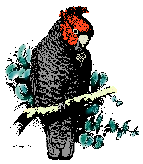|
Yesterday Barbara Allan and I drove around the MTA (formerly called Majura Firing Range). The weather was just about perfect for bird observation, pleasantly warm with no breeze until the last site around 11:00 am. The area is starting to show
signs of the dry weather, but most of the trees looked in pretty good nick, and the remnants of the grass were still on the greenish side. However, although we did not see too many kangaroos, the grassy areas were seriously overgrazed. We also spotted on
very red-necked wallaby.
We saw 35 species at the 7 sites, with 6 different species in between sites – one Superb Parrot; one Willie Wagtail; two Nankeen Kestrel; some Crested Pigeon; a couple of groups of White-winged
Chough and one White-eared Honeyeater.
The highlights of the morning were two Wedge-tailed Eagles being harassed by Australian Ravens. The eagles had not been observed for the past year or so. Other raptors included one Little Eagle, and the two Nankeen Kestrels. Summer migrants
were frequently observed at most sites, including White-throated and Western Gerygone, Olive-backed Orioles, Noisy Friarbirds and Rufous Whistler. Other summer migrants were seen only once or twice, including: Tree Martin, Black-faced Cuckoo-shrike, Leaden
Flycatcher, Pallid and Fantailed Cuckoo and some Grey Fantail.
Honey-eaters were scarce, with Brown-headed being heard at a couple of sites, a couple of Red Wattlebirds, Noisy Miners in only a couple of sites in low numbers, although it was their alarm calls that promoted a search for raptors that revealed
the Little Eagle soaring high above the bushland. There was a single observation of a White-eared Honey eater.
Some little brown birds were observed, although not in great numbers: Striated, Brown and Buff-rumped thornbills, Weebill, and Striated and Spotted Pardalotes.
The usual range of cockatoos and parrots were around in reasonable numbers, including: Sulphur-crested, Galah, Crimson and Eastern Rosellas, some Red-rumped Parrots, with one female appearing to be assiduously enlarging a nest hollow. The water
level at Mick’s Dam at the northern end of the reserve was quite low, but still supported a pair of Australasian Grebe, and another of Pacific Black Duck. No shovellers of any description.
Paul Fennell
Editor, COG Annual Bird Report
0407105460
|

